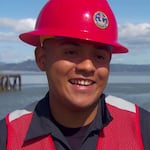Securing a vessel to a dock is hard, physical work. But Nadiyah Taylor handles everything without hesitation – from the cold drizzle coating the ship’s deck to her trainer’s insistent instructions: “Take in more slack. Don’t take it all the way off the cleat, just give it one half-turn.”
We met Taylor in September of 2016 aboard the training vessel Ironwood, a World War II-era buoy tender used in the Tongue Point Job Corps Seamanship program. She’d been in the Astoria-based course for about seven months at the time.
“It’s hard because I’ve never been this far away from home,” the Virginia native said. “But since everybody knows I’m trying to accomplish something great here, it gets easier.”
Taylor is one of 120 merchant mariner students hoping her hard work in Oregon’s dampest corner will pay off in a better future.
Related: Civilian Conservation Corps
The Job Corps was started in 1964 under the administration of President Johnson as a central part of his "War on Poverty." It was designed to be a safe, residential job-training program modeled after the Depression-era Civilian Conservation Corps to train people between the ages of 16 and 24 for work in a variety of industries, all at no cost to the student.
When we caught up with her again in December 2017, Taylor was ready to head back to Virginia with her newly minted “AB” (Able Seaman) and “QMED” (Qualified Member of the Engine Department) credentials in-hand.
“It gets you ready for the real world,” Taylor said of the program.
Actually, Taylor has been dealing with the “real world” since long before she joined Job Corps.

Seamanship cadet Nadiyah Taylor on her graduation day.
Jule Gilfillan / OPB
In 2005, Taylor’s 17-year-old brother Demario Joyner was shot and killed by police outside a Virginia Beach club where Taylor and her friends were attending a teen event. She was 12 years old. By the time Taylor was 18, she was the mother of two young daughters and at 23, she was working three jobs to earn enough to raise them.
At 24, Taylor became the seamanship program’s first African-American woman to graduate with both her AB and QMED credentials. On graduation day, she reflected on her brother Demario.
“He’d be excited. I’m kind of living his dream, you know,” she said, recalling how her brother was planning to become a marine seaman before he was killed. “It’s like he’s here.”
“The young men and women that come here, they don’t have a lot of opportunities,” says Len Tumbarello, a retired Coast Guard captain and director of the Tongue Point Job Corps Seamanship program. “They’ve had some tough things happen in their life. They need some financial help and knowing that they get three meals, a roof over their head, training, a place to go Monday through Sunday is a good thing.”
More than half of seamanship students come from underserved communities and are economically challenged. Students can earn their high school diplomas or GEDs while in the program. Some also go on to the MERTS program (Marine and Environmental Research and Training Center) at Clatsop Community College for advanced maritime courses, Tumbarello said.

Graduation day for the Tongue Point Job Corps Seamanship program in Astoria, Oregon.
Kianta Lee
“On average, our students have the opportunity to make $50,000 to $70,000 a year — right out of the gate — entry level.”
According to Tumbarello, about 95 percent of seamanship students currently complete the rigorous 18- to 24-month course to earn the U.S. Merchant Mariners credentials, and 92 percent of those land a job within six months of graduation.

Seamanship students learn to jump over the side and float in the water wearing an immersion suit.
Nick Fisher / OPB
Over the years, the federally funded Job Corps program has faced hurdles. Its funds are regularly cut or flat-funded. President Reagan proposed eliminating the program entirely on multiple occasions. Presidents Obama and Trump both proposed mild to moderate cuts to the Job Corps budget. Those cuts have never made it past Congress, which has continued to fund Job Corps at relatively stable levels.
“I don’t see it going anywhere,” Tumbarello says.
When he came aboard in 2013, the Tongue Point Job Corps Center had 60 seamanship students. Tumbarello says that the U.S. Department of Labor, which administers the program, understood the need for more mariners in the future and expanded seamanship’s enrollment to 120 students between late 2013 and 2014.
Last year, the U.S. Senate passed the "Domestic Maritime Centers of Excellence Act of 2017," lending Department of Transportation resources to support maritime training. Since the maritime industry is the single-largest importer and exporter of goods in the U.S. by weight, Tumbarello is bullish on the industry's ability to supply good jobs long into the future.
“A lot of the baby boomers are retiring and they’re going to have an opportunity to move up very quickly, Tumbarello said, referring to the sector’s incoming employers. A Department of Transportation report backs up that projection, calling for a 125-percent increase in job openings between 2012 and 2022.
Two months after graduating, Nadiyah Taylor landed a six-weeks-on, three-weeks-off job as a deckhand working on a cruise vessel plying the Mississippi River system. Four months after starting that job, she was promoted to bosun, a supervisory position where she oversees a crew of six. Taylor credits the skills she developed being away from home in Job Corps for earning that promotion.
“I learned how to handle people from various backgrounds and a lot of different situations that arise,” she said. Taylor is now studying for her mate’s license.
If she passes, the credential will open the door for another promotion and more money.
“My goal was to get one job where I could take care of my kids financially and have time off to be with them. It’s a great start and I make more money than a lot of other people I went to school with,” she confides with a laugh.
Now almost one year after graduation, Taylor’s job has given her the steadiness and security to dream.
“I’d like to have my own 24-hour daycare business someday,” says the single mom. “I love kids. But for now, as long as I keep my credentials up to date, there will always be work.”
Story Update
Since filming this story, other students featured from the merchant mariner training program have achieved new milestones:

File photo of Omar Bobadilla.
OPB
- Omar Bobadilla passed his final exams and graduated with his AB and QMED credentials Wednesday, 18 months after he started the program.

File photo of Zachary Wildes.
OPB
- Zachary Wildes also graduated and landed a coveted tankerman (fueling) job with Vancouver, Washington-based Tidewater Barge Lines.

